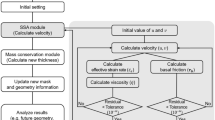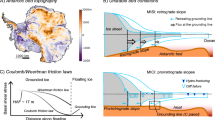Abstract
Recent satellite observations of the Antarctic and Greenland ice sheets show accelerated ice flow and associated ice sheet thinning along coastal outlet glaciers in contact with the ocean. Both processes are the result of grounding line retreat due to melting at the grounding line (the grounding line is the contact of the ice sheet with the ocean, where it starts to float and forms an ice shelf or ice tongue). Such rapid ice loss is not yet included in large-scale ice sheet models used for IPCC projections, as most of the complex processes are poorly understood. Here we report on the state-of-the art of grounding line migration in marine ice sheets and address different ways in which grounding line migration can be attributed and represented in ice sheet models. Using one-dimensional ice flow models of the ice sheet/ice shelf system we carried out a number of sensitivity experiments with different spatial resolutions and stress approximations. These are verified with semi-analytical steady state solutions. Results show that, in large-scale finite-difference models, grounding line migration is dependent on the numerical treatment (e.g. staggered/non-staggered grid) and the level of physics involved (e.g. shallow-ice/shallow-shelf approximation).




Similar content being viewed by others
Notes
This is less valid in the case of an ice stream, where upstream of the grounding line longitudinal stress gradients may be dominant.
‘Mixed’ means that the computed unknowns are the horizontal and vertical velocities as well as pressure (Lestringant 1994).
MISMIP: Marine Ice Sheet Model Intercomparison Project; http://homepages.ulb.ac.be/~fpattyn/mismip/
ice2sea is a science programme that is funded by the European Union Framework-7 scheme and will improve projections of the contribution of ice to future sea-level rise, http://www.ice2sea.eu.
SeaRISE (Sea-level Response to Ice Sheet Evolution) is a community organized effort to estimate the upper bound of ice sheet contributions to sea level in the next 100–200 years, http://websrv.cs.umt.edu/isis/index.php/SeaRISE_Assessment.
References
Baral DR, Hutter K, Greve R (2001) Asymptotic theories of large-scale motion, temperature, and moisture distribution in land-based polythermal ice sheets: a critical review and new developments. Appl Mech Rev 54(3):215–256
Blatter H (1995) Velocity and stress fields in grounded glaciers: a simple algorithm for including deviatoric stress gradients. J Glaciol 41(138):333–344
Chen JL, Wilson CR, Blankenship D, Tapley BD (2009) Accelerated Antarctic ice loss from satellite gravity measurements. Nat Geosci 2:859–862
Durand G, Gagliardini O, de Fleurian B, Zwinger T, Meur EL (2009a) Marine ice sheet dynamics: hysteresis and neutral equlibrium. J Geophys Res 114(F03009):170. doi:10.1029/2008JF001
Durand G, Zwinger T, Meur EL, Hindmarsh RCA (2009b) Full stokes modeling of marince ice sheets: influence of the grid size. Ann Glac 50(2)
Gladstone RM, Payne AJ, Cornford SL (2010) Parameterising the grounding line in ice sheet models. Cryosphere Discuss 4:1063–1105
Goldberg D, Holland DM, Schoof C (2009) Grounding line movement and ice shelf buttressing in marine ice sheets. J Geophys Res 114(F024026):227. doi:10.1029/2008JF001
Herterich K (1987) On the flow within the transition zone between ice sheet and ice shelf. In: Veen C, Oerlemans J (eds) Dynamics of the west Antarctic ice sheet. Kluwer Academic Publishers, Dordrecht, pp 185–202
Hindmarsh RCA (1993) Qualitative dynamics of marine ice sheets. In: Peltier W (ed) Ice in the climate system, NATO ASI series I , vol 12. Springer, Berlin, pp 67–99
Hindmarsh RCA (1996) Stability of ice rises and uncoupled marine ice sheets. Ann Glaciol 23:105–115
Hindmarsh RCA (2004) A numerical comparison of approximations to the Stokes equations used in ice sheet and glacier modeling. J Geophys Res 109(F01012):065. doi:10.1029/2003JF000
Hindmarsh RCA (2006) The role of membrane-like stresses in determining the stability and sensitivity of the Antarctic ice sheets: back pressure and grounding line motion. Phil Trans R Soc A 364:1733–1767
Hindmarsh RCA, Le Meur E (2001) Dynamical processes involved in the retreat of marine ice sheets. J Glaciol 47(157):271–282
Hutter K (1983) Theoretical glaciology. Kluwer Academic Publishers, Dordrecht
Huybrechts P (1990) A 3-D model for the Antarctic ice sheet: a sensitivity study on the glacial-interglacial contrast. Climate Dyn 5:79–92
Huybrechts P, Payne A, TheEISMINT Intercomparison Group (1996) The EISMINT benchmarks for testing ice-sheet models. Ann Glaciol 23:1–12
Huybrechts P, Abe-Ouchi A, Marsiat I, Pattyn F, Payne A, Ritz C, Rommelaere V (1998) Report of the third EISMINT workshop on model intercomparison. European Science Foundation, Strasbourg
Jenkins A, Dutrieux P, Jacobs S, McPhail S, Perrett J, Webb A, White D (2010) Observations beneath Pine Island Glacier in West Antarctica and implications for its retreat. Nat Geosci 3(7):468–472
Joughin I, Rignot E, Rosanova CE, Lucchitta BK, Bohlander J (2003) Timing of recent accelerations of Pine Island Glacier, Antarctica. Geophys Res Lett 30(13):609. doi:10.1029/2003GL017
Katz RF, Worster MG (2010) Stability of ice-sheet grounding lines. Proc R Soc A. doi:10.1098/rspa.2009.0434
Lestringant R (1994) A two-dimensional finite-element study of flow in the transition zone between an ice sheet and an ice shelf. Ann Glaciol 20:67–72
MacAyeal DR (1992) Irregular oscillations of the West Antarctic ice sheet. Nature 359:29–32
MacAyeal DR, Rommelaere V, Huybrechts P, Hulbe CL, Determann J, Ritz C (1996) An ice-shelf model test based on the Ross ice shelf. Ann Glaciol 23:46–51
Paterson WSB (1994) The physics of flaciers, 3rd edn. Pergamon Press, Oxford
Pattyn F (2000) Ice-sheet modelling at different spatial resolutions: focus on the grounding line. Ann Glaciol 31:211–216
Pattyn F (2003) A new 3D higher-order thermomechanical ice-sheet model: basic sensitivity, ice-stream development and ice flow across subglacial lakes. J Geophys Res 108(B8, 2382):329. doi:10.1029/2002JB002
Pattyn F, Huyghe A, De Brabander S, De Smedt B (2006) Role of transition zones in marine ice sheet dynamics. J Geophys Res 111(F02004):394. doi:10.1029/2005JF000
Pollard D, DeConto RM (2009) Modelling West Antarctic ice sheet growth and collapse through the past five million years. Nature 458:809. doi:10.1038/nature07
Rignot E, Bamber JL, van den Broeke MR, Davis C, Li Y, van de Berg WJ, van Meijgaard E (2008) Recent Antarctic ice mass loss from radar interferometry and regional climate modelling. Nat Geosci 1:106–110
Rignot E, Velicogna I, van den Broeke MR, Monaghan A, Lenaerts J (2011) Acceleration of the contribution of the Greenland and Antarctic ice sheets to sea level rise. Geophys Res Lett 38(L05503):583. doi:10.1029/2011GL046
Ritz C, Rommelaere V, Dumas C (2001) Modeling the evolution of the Antarctic ice sheet over the last 420000 years: implications for altitude changes in the Vostok region. J Geophys Res 106(D23):31943–31964
Robison RAV, Huppert HE, Worster MG (2009) Dynamics of viscous grounding lines. J Fluid Mech 648:363–380. doi:10.1017/S0022112009993119
Schoof C (2007a) Ice sheet grounding line dynamics: steady states, stability and hysteresis. J Geophys Res 112(F03S28):664. doi:10.1029/2006JF000
Schoof C (2007b) Marine ice sheet dynamics. Part I. The case of rapid sliding. J Fluid Mech 573:27–55
Schoof C, Hindmarsh R (2010) Thin-film flows with wall slip: an asymptotic analysis of higher order glacier flow models. Quart J Mech Appl Math 63(1):73–114
Schoof C, Pattyn F, Hindmarsh R (2007) Benchmarks and intercomparison program for marine ice sheet models. Geophysical Research Abstracts 9(EGU2007-A-04644)
Shepherd A, Wingham DJ, Mansley JAD, Corr HFJ (2001) Inland thinning of Pine Island Glacier, West Antarctica. Science 291:862–864
Thomas RH, Bentley CR (1978) A model for holocene retreat of the West Antarctic ice sheet. Quat Res 10:150–170
Velicogna I (2009) Increasing rates of ice mass loss from the Greenland and Antarctic ice sheets revealed by GRACE. Geophys Res Lett 36(L19503):222. doi:10.1029/2009GL040
Vieli A, Payne A (2005) Assessing the ability of numerical ice sheet models to simulate grounding line migration. J Geophys Res 110(F01003):202. doi:10.1029/2004JF000
Weertman J (1974) Stability of the junction of an ice sheet and an ice shelf. J Glaciol 13:3–11
Wingham DJ, Wallis DW, Shepherd A (2009) Spatial and temporal evolution of Pine Island Glacier thninning, 1995–2006. Geophys Res Lett 36(L17501):126. doi:10.1029/2009GL039
Acknowledgments
This work was supported by both the IceCube-Dyn project (Actions de recherche concertées) funded by the French Community of Belgium and the ice2sea project funded by the European Commission’s 7th Framework Programme through grant 226375 (ice2sea manuscript No. 20). The authors are greatly indebted to Gael Durand for his constructive review and to David Pollard who pointed out an error in the initially submitted manuscript.
Author information
Authors and Affiliations
Corresponding author
Rights and permissions
About this article
Cite this article
Docquier, D., Perichon, L. & Pattyn, F. Representing Grounding Line Dynamics in Numerical Ice Sheet Models: Recent Advances and Outlook. Surv Geophys 32, 417–435 (2011). https://doi.org/10.1007/s10712-011-9133-3
Received:
Accepted:
Published:
Issue Date:
DOI: https://doi.org/10.1007/s10712-011-9133-3




